Exit Interview: What It Was Like To Drive A Horse Carriage In 1980s New York
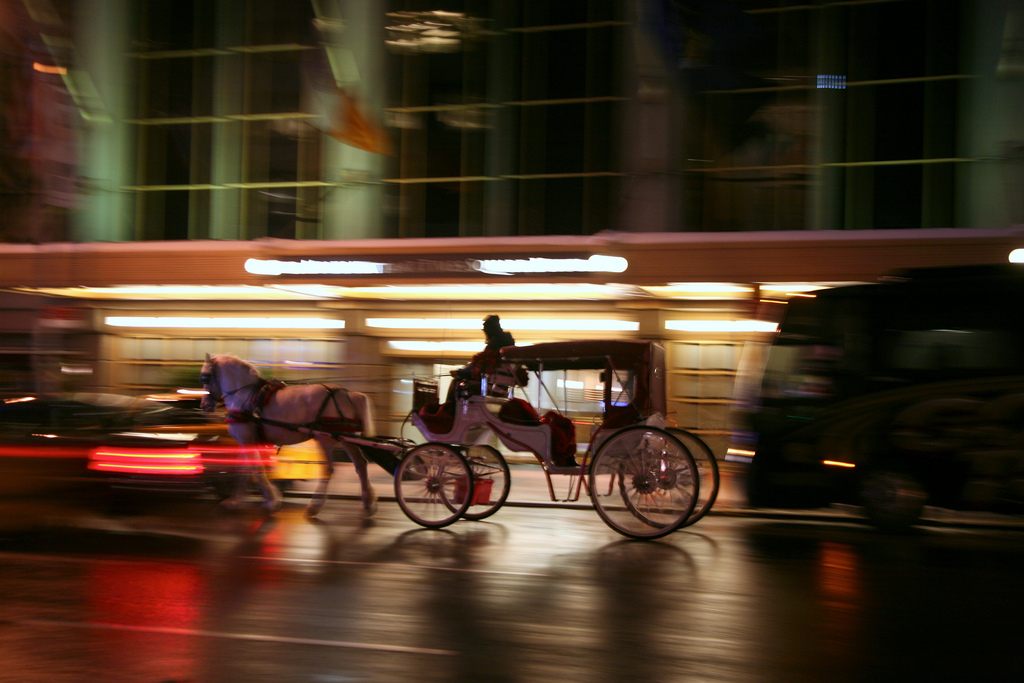
A horse carriage on the modern streets of New York. (Photo: (vincent desjardins)/Flickr)
Among the most iconic and enduring sights around Central Park are the horse carriages. A holdover from a bygone time, the New York carriage ride has managed to hang on through the breakneck evolution of the city’s transportation attractions.
Today, the horse carriages are only allowed to operate in Central Park, but just a few decades ago, the carriages had potentially free reign over the Manhattan streets, competing with traffic and the insanity of the city just like everyone else. New York Mayor Bill de Blasio has taken a strong stance against the carriages, which he sees as inhumane, and the horse-drawn carriage industry may be on its last leg.
Regardless of one’s feelings about the industry, it has long been a singular New York institution, and to get a better idea of what it’s like in the driver’s seat we spoke with travel writer, and former carriage driver, Bruce Northam, author of multiple travel memoirs including his new book, The Directions to Happiness: A 135-Country Quest for Life Lessons. Northam drove a horse-drawn carriage on the twilight streets of Manhattan for three years in the wild 1980s, when carriage driving was all about what type of outsized persona you could concoct. He let us in on his tricks for picking up customers, his thoughts on de Blasio’s current campaign, and even how he got his old horse, Jerome.
So when did you first start driving a carriage?
Right out of college. I drove off and on from ’85 to ’88, except for 1987, where I did my first around the world journey, which focused mostly on Southeast Asia, and was funded by the carriages.
So it was essentially my first job out of college. I graduated with a BS in Physics, so I don’t think my parents were thrilled about that being my first job, but it ultimately led me into travel writing.
So you were a physics student in college–how did you become a carriage driver?
Well, I had just gotten back from college, and my older brother Brian, who was pursuing acting in the city, he was driving a carriage. I’d heard incredible tales, and he was doing well, so it just seemed to make sense. You know, driving a carriage falls into a category with waiter and bartender. But it’s different, and I think it’s absolutely more enjoyable.
It was a different business at the time. Now, you only see carriages in Central Park. When you were driving, carriages pretty much had free reign, correct?
Absolutely. Manhattan was still the Wild West. Nine of the ten theaters in Times Square were [showing] porno flicks. You could still buy fake IDs and drugs all over the place. So the Department of Consumer Affairs which monitors the bylaws of the carriage industry were very hands off, and we could ride right out of the stable.
The past 20 years, rules were made to keep carriages exclusively in the park, but at night, around 9:00, you were allowed to go to Rockefeller Center, and by 11:30 you were allowed to go into Times Square.
So it’s totally different—it’s all about the park now. When I was driving, I would literally leave one of the West Side stables I was working in and head straight to Times Square, the Rock[efeller] Center, or 52nd and 7th in front of Rosie O’Grady’s. I’d work there all night, and only go to the park by way of customer request.
There’s a lot going on politically with the carriages right now. For a while the ASPCA was on our case. That’s over. At a certain point the cops and the mounted cops would be on our case—that has stopped.
It’s basically an Italian and Irish industry, and it’s completely self-policing. These people know horses, and they know what they’re doing. It’s their career. If some bozo cowboy comes in and is going to run a horse or take a horse out that might have a sore foot or something, that person wouldn’t just be reprimanded. If they took it to the next step of being an idiot, they’d get beaten up. So it was old-style self-policing.
And it’s still completely self-policed. Everybody sees everything. There’s 68 medallions, that represents two full time jobs. You have 68 carriages going out in the daytime and then 68 going out at night. The day driver heads back to the West Side stables, they change out the horse, and the night driver heads out.
So at any given time, generally speaking, there’s 68 carriages around Central Park?
Well, when the weather’s nice, tourism is up—everyone goes out. But certainly on rainy, cold days, lonely Tuesdays in January—you might just see ten carriages out.
There was something like 25 carriage medallions in Central Park up until World War II. And then, when the war was over, more people wanted to come into the city to celebrate, and they jumped the number to 68 carriages, where it’s remained since post-World War II.
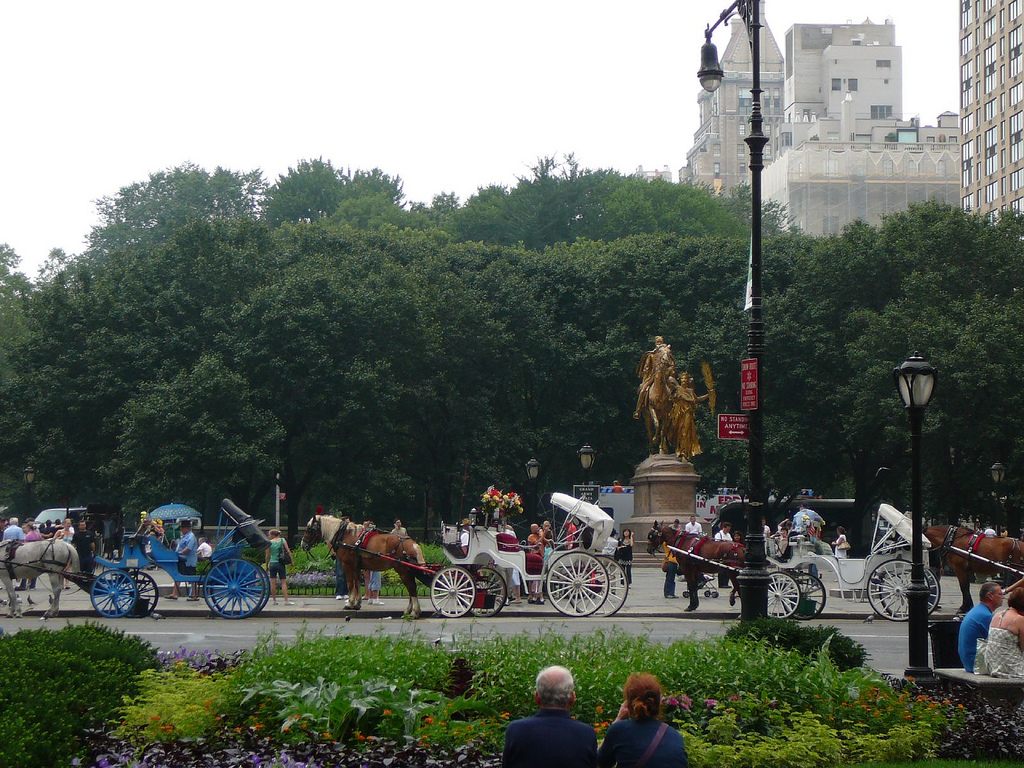
The carriages outside Central Park. (Photo: Matt Grommes/Flickr)
Why 68? That seems like a very specific number?
I don’t know. But what I will tell you, is that Uber has dented the value of a taxi medallion, but it has had no impact on the value of a carriage medallion.
So who owns the carriage medallions?
People! People like me and you. As I said, historically, it was heavily Italian and Irish, and now it’s their descendants. In the past ten years, there’s been a pretty strong infusion of Turkish drivers.
But it’s a real multicolored tapestry of people. When I was doing it back in the ‘80s, it was a lot more geared towards actors, magicians, musicians. Now it’s become more like a job, to raise your family, and to finance your life, permanently.
Just to get a better understanding of how the industry works: there’s no one centralized company that owns all the medallions?
No. The centralized company would be the Department of Consumer Affairs, because just like taxi medallions—they monitor and control the carriage industry also. It’s bought and sold just like a taxi medallion.
Going back to your experience, did you get to pick a horse that you had an affinity with? How did the process go?
It would be like any job that relies on tips. You start at the low end of the totem pole. Just like the bar business or the restaurant business. You start out getting the Tuesday shift, and you work your way up, until you get the weekends. Some people are part time, some are full time. For me, I had a brother who was doing it at the time, so I had an in.
You really have to show, just like when you go into the military and you have to prove that you’re physically able, you have to be extremely aware to be a carriage driver. Horses are really sensitive to sounds and feelings, and you don’t want a two-ton animal being upset in traffic. The Department of Consumer Affairs test has gotten tougher—the written test.
[During training] you end up with a vet, talking about horses, and body parts, and what can go wrong. But the real training program is in the streets. You literally go out and ride along. And there’s so much that goes on.
Every horse is different. Some horses aren’t fond of when a beer truck opens its side door, and that noise. Some horses aren’t very fond of subway steam shooting out of the street, so you have to know which routes to pick, what your horse’s personality is. But again, the horses who come in—they try out also.
The horses come from Amish country, and that’s another thing that people don’t understand about the industry. These weren’t horses that were snatched from Kentucky bluegrass farms. These are Amish horses that were pulling carriages in the Amish country or literally plowing fields. They’re not alien to pulling things.
It’s usually a second chance for the horses. At the auctions out in Amish country in Pennsylvania, if they’re not picked up as carriage horses—it’s straight off to the dog food market.
So most carriage horses are older when they start?
No, they’re different. I mean there are some career horses that are in the city for 20 years. But some horses are trucked in from the Amish country, they go around the block a few times on some quiet night in the more rustic parts of Hell’s Kitchen, and some horses just are not cut out for it. Just like some people aren’t cut out for the city.
When you were driving around in the city did you have a specific horse you were assigned to so that you could have a relationship with it?
Yes. People stick with the same horse because it’s important that you get to know the horse. And know its personality.
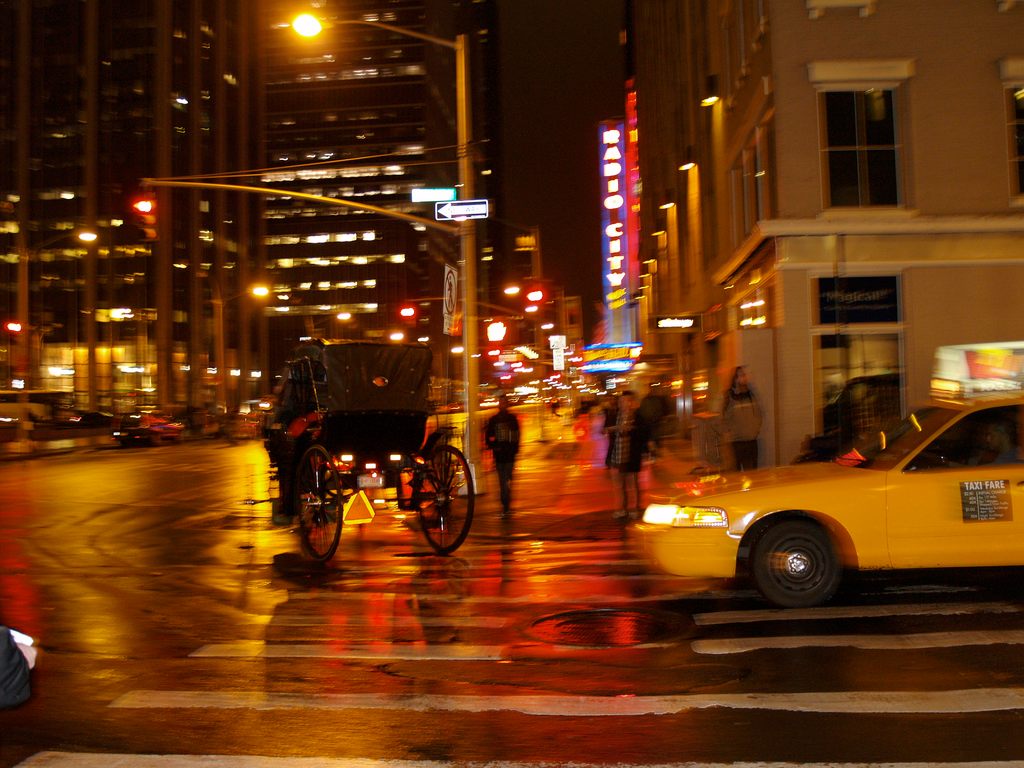
(Photo: eyeliam/Flickr)
What was your horse’s name?
My horse was Jerome. He was a Strawberry Rhone. And again, when I was driving him it was the wild ‘80s. I would go out sometimes with the black tuxedo pants, no shirt, and a bowtie, and drive around the city and whatever. Narcissism can run deep when you’re just out of college. It was truly the Wild West.
Now, by law, only one person can sit up in the front of the carriage and drive. The only person that can be up there with you has to have a license. You’ll either be training a driver, or two drivers training a horse. So if you ever see two people up front, it’s either a driver in training or two experienced drivers training a horse in the city, so if anything goes wrong, one of them can jump off and take care of it.
When you were driving was there a sense that it was you and Jerome against the city, in a way?
No. The enemy of the carriage forces is not the taxis as you would expect. It would generally be the black airport service cars. Those were generally the ruder drivers. New York City is a crazy place, but most people, they just want to make it work.
So no, it was very with the city. It’s a very social job. It’s one of the rare tourist industries where you can walk up, and you have a choice between dozens of personalities. Between driver, carriage style, horse, and back when I was doing it, your route. Now the route is much more fixed. It’s either a short ride in the park, or a long ride in the park.
But in your day, you could, in theory, go anywhere in Manhattan?
Yes, but it’s just like a taxi. If someone wanted to go down into the Village, it’s a bit far for the horse, and then you might get stuck empty coming back. You wanted to be where the tourists are.
Walk me through a typical night from arriving at the stable on. At least what it was like when you were doing it.
Interestingly, it really hasn’t changed that much. I was a night driver, so I’d show up and wait for the day driver to come in. Back in the day, the drivers were responsible for saddling and harnessing the horses on their own. Which makes sense because you have to know your equipment.
So you’d help the day driver unhitch his horse and then bring down the night horse. You’d hook it up, put a bucket of oats under the carriage, then another bucket for water, that you would access through the night from either fire hydrants, or now, up at the park they have two water troughs for the carriage horses. Then out to work!
Carriage drivers are called hacks. It’s a hustling sales job, and you needed to know where to be. So for me, I had it down to such a science that I’d do couple of rides early in the night, then I’d work the theaters. That’s over, but [at the time], I knew that Cats would break at 10:10, and I’d hit that. Then ride around Rock Center and parts of 7th Avenue. Then, bam, another show would break at 10:40, and I’d be right in front of that when the theater broke. You were guaranteed a couple of rides when the theater broke.
And the horse can’t work more than nine hours, so the business would be over by midnight or one.
What’s really interesting about the politics of de Blasio’s attempt to ban the carriages, which looks like it’s going to completely fail, is that there was this controversy behind all of it. Because a real estate group, for we’ll just say, an unnamed real estate group is very interested in the four stables on the west side of Manhattan, 37th Street, 38th Street, 48th Street, and 52nd Street. They want that real estate.
So basically the controversy is that these real estate developers put a lot of money into de Blasio’s campaign to do two things. To speak out against the carriages and attempt to ban them, and they also funded some animal rights groups to turn up the heat. So that they could put the carriages out of business, and those stables would be useless to the carriage industry then they could be bought, demolished, and turned into luxury high rises.
You took a year off, did you get the a different horse when you came back?
No, I got the same horse. I got Jerome when I came back.
Was he happy to see you?
Yeah! Horses know people and it’s all about voice and affection.
So going back to the job, you would take the horse out on the route and the head back to the stables on the west side.
My first stable, I worked out of all four of them in the ‘80s, but my first stable was on 11th Avenue between 37th and 38th Street, and that’s now a park which opposes the Javits Center, which was built in the mid-80s.
When you would go and pick people up at the theaters and such, was there ever any conflict or rivalry with other drivers?
No. It’s a small industry. Just like in [Central Park today], let’s say there’s two drivers on the curb. You have first right for everything coming from one direction, and the other driver has first right for everything coming from the direction towards him. So while the passengers are walking along a row of horses, and [this line up] is on 59th Street in the park now, the drivers can only hack and approach those customers from the distance of the back wheel of your carriage to the nose of your horse. That’s your space. The minute a passenger enters another driver’s zone, that’s their turn to give it a shot.
In the ‘80s, when a driver was waiting out front for the theaters to break, that was more of a free-for-all, and everybody was guaranteed rides, so there was less conflict.

(Photo: Jimmy Baikovicius/Flickr)
It seems like back then, you guys were more theatrical about getting passengers in. It seems like each carriage had its own flavor.
Oh yeah. There’s different styles of carriage. Different colors, models. They’re all hand-made in Pennsylvania’s Amish country.
The carriages on Central Park are much more homogenous and the drivers seem much more restrained than in your day. You’d mentioned to me a story about your brother.
Yeah, my brother, you will never see that again. My brother had a pet monkey, a capuchin, the kind of monkey that can [act as a service animal]. He also picked up a goat while buying the horse at the Amish auctions. And he would go out with the monkey and the goat, and nobody’d say anything. The cops would look and smile and laugh. He got a lot of rides.
Were there any other drivers who had other memorable gimmicks?
We had a magician who would do card tricks. There was a guy for a while who had a parrot on his shoulder. Some people would do it by dressing up, either like a cowboy, or in a tuxedo. But mainly it’s the gift of gab.
When the people are on the ride, they don’t even see the horse, so it’s all about the driver. Some people are in a romantic mode, and they don’t want a tour, they just want to be together. But most people want to interact and they want to hear about the city, they want to hear about you, they want to hear about the industry. They have questions very similar to the ones you’re asking.
The trick you learn as a carriage driver, if you get kind of burnt out after answering the same questions every day, like, ‘Have you ever been mugged?, You ever meet anybody famous?’ you just turn it around on them. You ask any couple, ‘How did you meet?’ all of a sudden, you’re in for a 30-minute tale. If it’s fun for them, it’s fun for you.
What was the most standard complaint you would get from riders?
That the ride didn’t last long enough. But most people really enjoyed and got what they paid for.
What do you personally think the continuing appeal of the carriage ride is?
It’s iconic. It’s an iconic New York institution. People come to the city and on their list are certain things. They want to go up high in a building, Empire State Building, World Trade One, or the former twin towers, Rock Center. They’re gonna see a Broadway show. They have specific places they want to eat. And they are going to go on a carriage ride. I think a lot of it’s driven by Hollywood. Hollywood portrays carriages as glamorous and romantic.
Why did you end up leaving carriage driving?
Because I became a travel writer. I’ve since authored four books, I make a living writing for magazines and website and book royalties.
Was there a moment when you decided to leave it behind and move on to your new career?
At the end of the ‘80s, I went on another year long, circle of the Pacific Rim trip. That’s when I started travel writing, so from then on I was doing what I always wanted to do.
Do you miss it?
Now that it’s confined to the park, it seems a little bit more like a job to me. But I do miss it. I do miss a chance to talk to people from all of over the world, and there’s a camaraderie among drivers. What I don’t miss is being outside in the rain and the cold weather.
Do you miss working with the animals?
Absolutely. I love horses.
Do you ever get over to the stables any longer?
I still have friends in the business. I still go talk to the guys frequently, whenever I’m walking along 59th Street. Whenever I get into Hell’s Kitchen, I’ll pop over to the stables. It’s too bad more people can’t see the stables. The horses have 24-hour care, full-size box stables, electronically delivered water. They’re groomed and brushed every day. The horses get more vacation time than the humans. Many drivers have two horses and they trade out every three months. The horses get eight weeks vacation every year, generally out in the Amish country or in farms within 100 miles of New York City.
I’d say a third of the horses that come in for a trial run in the city, it doesn’t work out. They head back out to the farm. It’s a mellower horse that adapts to this job.
Do you know what happened to Jerome?
In 1992 he was retired to a farm, and he passed on two years later.
Were you alerted when he passed away?
I wasn’t, but I do remember the day when he was sent out to retirement on the farm. My brother kept me abreast of how he was doing.
Does your brother still hack?
He did until 2000.
Do you have any final thoughts about your time as a carriage driver?
It was an incredible set up for meeting people from around the world before I went off to explore the world. I’ve now been to 150 countries, and many of them more than five times, some of them more than a dozen times. For instance, Britain, Thailand. So it was my set up to meet people from Australia, New Zealand, Brazil, England, France, the whole planet. And also people from all over the states. So even before I struck out to explore the world, I had already met it driving a carriage.
What is your current project?
My new book is called The Directions to Happiness: A 135-Country Quest for Life Lessons. It’s 135 stand-alone short stories. Essentially it’s my Chicken Soup For The Soul, but with balls. It’s the life lessons I learned out there. It’s other people’s unsung hero wisdom that I’m delivering in the form of short stories. There are a couple of carriage stories in the book.
To see more of Bruce Northam’s work, visit his website, American Detour.
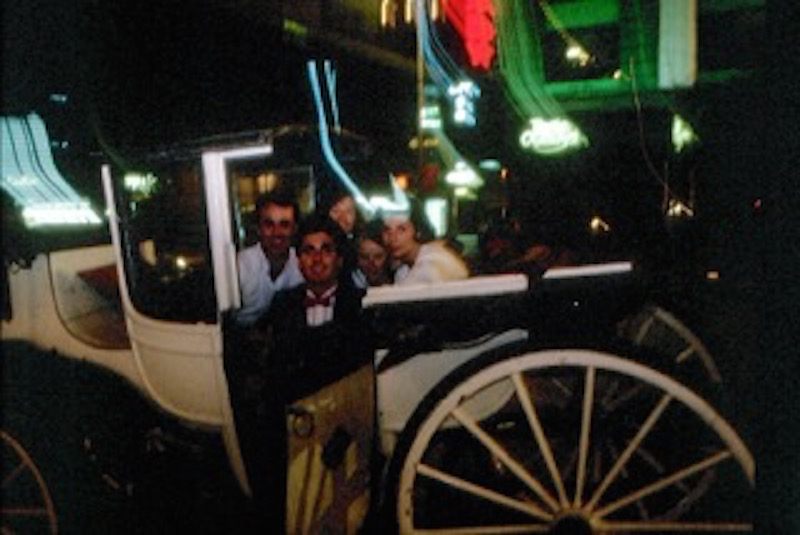
Bruce in his carriage in the 1980s. (Courtesy of Bruce Northam)






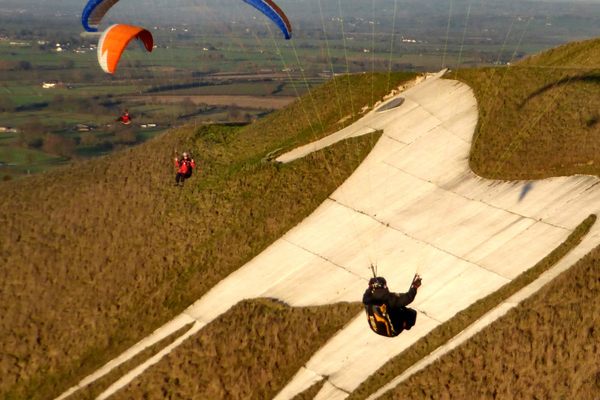














Follow us on Twitter to get the latest on the world's hidden wonders.
Like us on Facebook to get the latest on the world's hidden wonders.
Follow us on Twitter Like us on Facebook